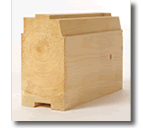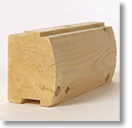

There are some that think the logs used in log homes are created equal. That's why many potential consumers think all logs should all be priced the same. As with any product, there are differences in quality, thus differences in price. Let's take a look at a few of these differences.
THICKNESS - Most log home companies will advertise 6", 8" or 10" thick logs. When you go and actually MEASURE these logs you'll find they are 5.5", 7.5" or 9.5" thick. Appalachian produces FULL THICKNESS logs for our log cabin homes, thus more wood AND more insulation. Using full thickness logs will typically add between 15% and 20% more wood product to your home - stronger, safer, added insulation - a lot more benefits for the same price!
GRADE STAMPED - Know the difference between a graded log and a grade stamped log? A grade stamped log guarantees that your log home building materials are structurally sound and approved to meet building codes. Building inspectors will be looking for this stamp on each of your logs to verify that they meet the ASTM specifications. Many log home companies talk about "graded logs" - BEWARE - these are NOT GRADE STAMPED logs. Graded could mean a visual grade (not structural) or just that the guy running the mill thinks it looks good so he gave it a good grade. Quality is the difference - you'll pay less (and get less) with a non-grade stamped log. We've heard from folks who purchased from other log home companies who did not grade stamp their logs and were surprised when the local building inspectors arrived at the job site and stopped their project. They had to hire a specialist to come and grade stamp their logs before they could continue. This not only added more time to the project but also more money!
SPECIES - Still believe there is one wood species better than the rest? Do some research and you'll find that besides some color and grain difference they are all about the same. Think cedar or cypress is impervious to rot/decay or wood digesting insects? Think again and start doing some research for yourself. You'll soon discover that these species, just like all the rest of the wood species, need to be protected with preservatives for great looks and longevity. Remember - if there were a perfect wood species to build log homes with - ALL of the log home industry would be using it. We use White Pine because it is a wood species that is abundent in our area, easy to work with and takes our borate pressure treatment easily and completely. You'll find most manufacturers using a wood species that is close by to their manufacturing facilities.
TREATMENTS - What is the optimum way to protect a log wall? Research pressure treatment and see why it is the only way to go. Research Borates and you'll soon learn why we pressure treat with this organic (non-chemical) product. In the 35+ years we've been providing pressure treated log home building materials, not one of our homeowners have had to replace/repair any of their pressure treated materials we've provided. Once again, you can save LOTS of time and money by investing in good quality products upfront and not spending LOTS of time/money on maintenance over the years taking care of your log home.
Now that you begin to understand that not all logs are created equal, you'll start to understand some of the differences in QUALITY and pricing. When creating your dream log home think about the type of products you want surrounding you and your loved ones as well as the quality of materials you plan to use in one of the largest investments you'll be making in your lifetime!
Don't forget to contact your local Log Home Building Consultant to discover more about our log home building components and how they can save you time and money not only today, but for the lifetime of your log home.
Be sure to follow us on facebook!


.png?width=137&height=70&name=blue-seal-120-61-bbb-21001218%20(1).png)